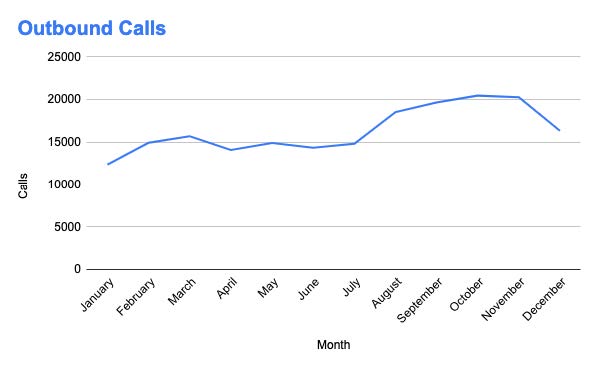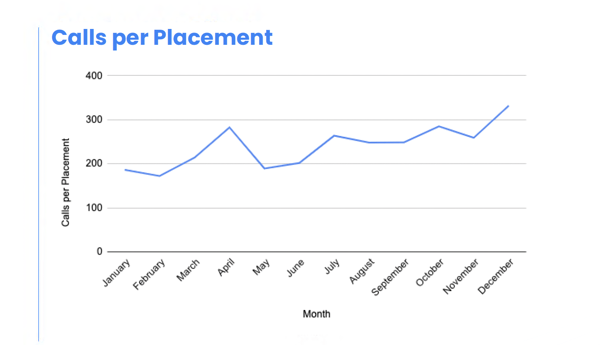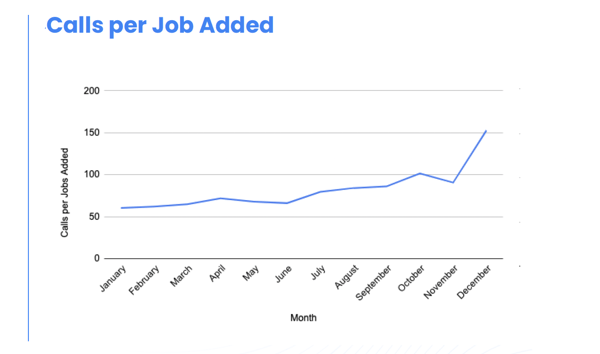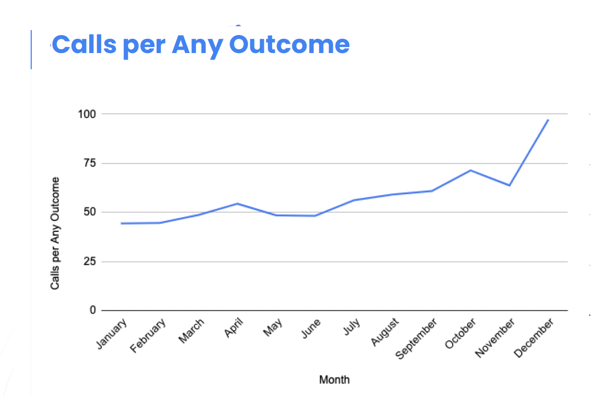Sales productivity across the recruitment sector is an ever-changing landscape - and that usually means endless metrics! As we analyse these numbers, patterns emerge that the industry can learn from, allowing us to plan for the future and decide which metrics to focus on.
With data pulled from the OneUp Sales platform, we’ll be examining the times of year when recruitment companies see the most revenue per call, when the most placements are made, and other interesting industry trends.
We’ve analysed data from over 1000 permanent-hire recruiters across two years - 2021 and 2022, to see what the trends are and what direction they seem to be moving in. With a look at these past two years, expectations for the current quarter, and the actions we need to take to ensure a successful future, let’s dive into the state of sales productivity in the recruitment sector.
Foreword: Derry Holt, CEO of OneUp Sales
Contents:
What Has the last 2 Years of Recruitment Looked Like?
The Data Trends in Permanent Recruitment
What Does the Data Mean for the Future of the Recruitment Industry?
6 Top Tips to improve Recruitment Consultant Productivity
What has the last two years of recruitment looked like for our customers?
It is important to note that over the past two years, the world has still been recovering from the global fallout caused by the Covid-19 pandemic. The recruitment industry is no exception, and all areas of the corporate world were caught up in the impact of what happened in March 2020 and the following months.
That’s not to say that the recruitment industry saw a period of failure - quite the opposite. Many of OneUp’s clients have said that 2021 and 2022 have been "golden years" in the world of recruitment. Thus, the data we’re analysing represents a period of success for the industry, and we can only hope this continues.
Generally, though, things have been slowly getting back to some version of normal, and one thing our data analysis proves is that 2022 was a much more consistent year than 2021 in the recruitment world. For example, when we look at the average number of calls made by our clients, this number rises steadily throughout 2022 until it drops down in December (a notably quiet month for making calls, adding jobs, and sending out CVs).
But during 2021, the number of calls made fluctuated throughout the year - things were much less consistent in the industry. This is a pattern we noticed when analysing all of the data, and something you’ll notice as you work through this report.
Using this data example, i.e the number of calls made, it is important to note that this metric is generally representative of a few different things. So when more calls are being made, there is usually a reason for this - and vice versa. It’s worth looking beyond the statistic itself to see why it’s happening this way.

Data trends in recruitment
In this section of the report, we’ll present you with the data we have collated - hopefully in a way that will be both actionable and clear.
Key terms:
Calls made - any calls made by recruiters to clients and candidates.
Jobs added - any job vacancies added to a recruiter’s job board.
Interviews booked - where a recruiter has successfully set up an interview between a client and a candidate.
Placements - where a candidate has been successfully placed in a job role.
CVs sent - where a recruiter has sent a candidate’s CV to a client/potential employer.
Revenue per call - how much revenue is generated per call made.
Headline Stats for 2021 and 2022:
1. On average, recruitment companies make the most calls in October and November, with the least being made in the first half of the year.2. October was the busiest month for jobs being added - while January and February had the least jobs added.
TIP: Knowing that January and February are often quieter months in terms of making calls and adding jobs, make sure to use December’s slower time to prepare for this: send out some LinkedIn messages ready for people to reply to in the new year, refresh your email templates, and potentially focus on training.
3. July right through to November were the months when recruitment companies sent out the most CVs in both years.
TIP: Capitalising on consistency is really important in recruitment; you can keep these high rates going through December-June by looking at ways to continue incentivising your team as part of your company culture. We use the OneUp gamification and competition features to keep sales teams incentivised.
4. When it comes to interviews being booked, this number was much higher from September-November of 2021; it dropped off in December but was consistent throughout 2022 with a spike in May.
5. 2021 saw a steady increase throughout the year in terms of placements being made with a drop in December - this number remained fairly consistent in 2022 with another spike in May.
6. The end of the year is when recruitment companies make the most calls per outcome (e.g per placement OR per job added)
TIP: As we’ll see during the course of this report, there are a lot of things you can do to make the most of the end of the year - especially December. It can be somewhat of an anomaly in the data sometimes, but you can spend this time using different ways of staying in touch e.g.through LinkedIn messages, in-person meetings, Christmas cards/gifts, videos, or even some digital marketing techniques such as ad retargeting since it's taking more calls to place a candidate or add a vacancy.
7. When it comes to CVs sent per placement AND interviews per placement, we can see that this is consistent throughout the year. Of the OneUp clients we have looked at in this report, the benchmark for CVs sent to placements made was 24 CVs to 1 placement.
TIP: If your data doesn’t reflect the same consistency when it comes to sending out CVs (i.e you’re sending out too many per placement) then it’s definitely worth looking at how you can fine-tune your process in order to ensure recruiters are sending out the right CVs the first time around.
8. In 2021, average revenue was higher in July and September than it was during the rest of the year; in 2022, the highest revenue months were March and May. From looking at this data and speaking to people across the industry, we suspect that the 2021 revenue numbers were affected by the end of lockdown and that the 2022 revenue numbers were affected by the start of recession fear and the cost of living crisis.
TIP: Taking the socio-economic and political factors out, it is really important, from around May, to try and control the communication between clients and candidates as much as possible to ensure the revenue does come through. This time of year is close to the summer months when candidates are looking to book holidays (or might have done so already!) and, if they are in conversation with the client, then there is the potential for the placement date (and the revenue generated from this) to be pushed back.
9. January-March is when recruitment companies see the most revenue per call, perhaps due to a more motivated mindset combined with companies ending (or coming to the end of) their financial year. April-June also sees a fairly high amount of revenue per call, which drops off from the summer - typically due to decision-makers heading off on holiday.
TIP: Adapting to the time of year is really important; certain months will always generate more revenue per call, but continuing incentivisation across your company all year round will definitely help. Being more creative in how you communicate with your clients, as well as being able to ask and know when your clients are off and guiding them in the process of hiring, will help consultants have more predictable revenue.
We can look at and present this data in different ways - for example in February, it took 173 calls to close a placement. But by the time December rolled around, that had almost doubled to 332, showing the extra effort recruiters had to go to to find the right client, the right candidate, and create a lasting partnership between the two. When we present this as ratios, it looks like this…
February calls to placements - 173:1
December calls to placements - 332:1

And when looking at how many calls it takes to get a new vacancy/job added, this was at its lowest in January when it took 61 calls to add one job. Again we see that this more than doubled in December when recruiters had to make 153 calls per job added to get the ball rolling on matching clients with the perfect candidate. Presented as ratios, this is how that looks:
January calls to jobs added - 61:1
December calls to jobs added - 153:1

There is a clear pattern emerging here. When we look at the average ratio of calls to general outcome - this being placements made *and* jobs added - this sits lowest in January (44:1) and highest in December (97:1).

What does this mean for the recruitment industry?
It’s all well and good just looking at this data and moving on - but that’s certainly not the reason we wrote this report. So what has changed over the past two years? We can see where life started to settle down again in the corporate world following the pandemic, as things seemed to steadily get busier throughout 2022.
An important consideration to make is that we are currently (and have been for the past few months) in a cost of living crisis. This has had and will continue to have an impact on the recruitment industry - whether it’s people looking for new jobs that pay more or allow them to work from home and save on their commute, it is only natural that with a dip in wages and a lack of pay rises, employees will move around. Reports from CV-Library in April 2022 showed that 71.5% of UK professionals were currently thinking about or looking for a new job due to the cost of living crisis. With inflation rising and Recruitive reporting that 48% of workers had stated they had not been given a pay rise, is it any wonder that people have been looking for new jobs to support themselves and their families?
With all of this in mind, it stands to reason that 2022 was a busier and more productive year in recruitment than 2021. For example, throughout 2021 the average number of jobs added per month was in the 100s or 200s. But in 2022, the number of jobs added per month was in the high 200s, the 300s or even the 400s. If we discount December when analysing this data - as this is almost an anomaly when it comes to how many jobs are added, then we can see that even the month with the lowest number of jobs added in 2022 had more jobs added than the month with the highest number in 2021!
Recruitment companies sent out many more CVs in 2022, too. If we discount December again, the highest monthly average number of CVs sent in 2021 was 1307 in November - which is lower than 2022’s lowest month (1591 in April). This in itself is a clear indication that many more people were job hunting in 2022 than in 2021, which is something we can expect to see increasing even more so.
What Can We Expect In H1?
We’ll be looking more to the future in due course but for now, what can we expect from the recruitment industry in H1 of 2023?
First of all, January-March is when recruitment companies tend to see the highest revenue per call. Our data shows an average of £59.99 in revenue per call across this quarter, which is higher than any other quarter previously. So we’re starting off strong when it comes to predictions for the first quarter of 2023!
This is despite the fact that January-March are the quietest months for making calls and adding jobs - which means you can potentially enjoy a slower pace while making more money. Many of our clients were making upwards of £70 in revenue per call during this quarter last year, and while these amounts were occasionally replicated later in the year it was much more consistent during the first three months. In March 2022, average revenue was at its highest of any point in the year, which is a good sign.
The spike in revenue could be for many reasons, but a lot of it likely comes down to the whole ‘New Year, New Me’ outlook on life. We spoke to a few people on our team who have experience in the recruitment industry, and they echoed the ‘New Year, New Me’ sentiment completely. While it may induce eye-rolls for many, it is undeniable that the beginning of a brand new year seems like a logical time for a fresh start. This translates to people leaving their jobs for pastures anew - e.g., filling the vacancies added during the busy month of October! This creates a domino effect and more vacancies get filled.
As mentioned, the beginning of the year seems to be a slower time of year in terms of activity within the industry. This isn’t to say it’s "slow", just that the data suggests it isn’t the busiest quarter when it comes to these particular parts of the job.
You will likely still make a solid amount of calls and add plenty of jobs, but you can expect this to pick up even more as the year goes on. At this point, it might be worth looking at ways in which you and your team can increase activity. Because there is a higher average revenue per call at this time of year, it seems likely that making more calls will lead to even higher revenue.
Many recruitment companies heavily incentivise during December, because they know it will be a slower month; there is no reason however, to slow things down. When you look at the revenue per call data for the beginning of the year and see just how good it is, it makes sense to capitalise on people's motivation and productivity to set higher targets and generate more income.
How does the future of recruitment look based on this data?
The most important thing we want to achieve with this report is to give you some actionable advice for making 2023 and beyond successful. So what should you be focusing on as a team to increase your sales productivity?
First things first: the cost of living crisis isn’t going away; we are seeing more and more industries striking - from bus drivers to nurses to teachers, people are standing up for themselves and their lack of pay rises. This shows that people are not happy, and know they deserve more.
When pay rises don’t happen or aren’t in line with inflation and so on, people are likely to decide it’s time for a career change. Whether they want a higher salary, a lesser commute, hybrid working or a better pension, it is likely that we’ll see a further increase in job hunting.
In terms of our data, we saw a huge jump in the amount of CVs sent between 2021 and 2022 - this is likely to continue growing. With more competition for the same role(s), recruiters need to make sure they step up in terms of candidate and client service and support levels if they want to continue to add jobs and make placements.
The December drop
Something we can see time and time again within this data is that there is a drop in December: fewer CVs sent, fewer placements made, fewer jobs added and so on. October and November might be really busy, but it’s like everything falls off a cliff as soon as December arrives - there’s a sharp drop in numbers for various trends. Recruiters need to work harder at this time (make more calls) to reach desired outcomes.
This is worth noting, and perhaps you’ll want to switch things up in December - be more creative in your recruitment activity, and definitely diversify the ways in which you reach out to candidates. Don’t be the recruitment company that pushes activity for activity’s sake; for example, asking recruiters to make a certain number of calls without actually being focused on potential outcomes - as long as they hit that specific number. This isn’t an efficient way of working, as there’s no point hitting arbitrary targets if they’re not leading anywhere.
A great idea when it comes to looking ahead to Q4 is to think about condensing your quarterly targets into just October and November - the knowledge that December will be quiet is critical, because it means you can push harder in the previous two months and work towards your targets then instead.
Despite this December drop, the month is definitely not a write-off! It gives you the opportunity to focus on things outside of the typical day-to-day recruiting activity. Many recruiters spend this time reaching out to clients and candidates they have interacted with throughout the year - sending Christmas cards to clients, for example, or checking in with candidates they’ve placed in jobs to see how they’re settling in and potentially asking for referrals.
Another great way to spend your time as a recruiter in December is to focus on those admin-specific tasks which get missed during the busier times of year. Things like team training, refreshing your email templates, and putting together new documentation. December is the perfect opportunity to ensure you have an organised and successful January.
6 Top Tips for Increasing Sales Productivity in the Recruitment Industry
Looking at the activity to outcome ratios such as calls per placement and so on, we can see that the end of the year is technically the least productive within the recruitment industry. It's taking more calls to reach a desired outcome such as adding a job or making a placement, and our clients are also making fewer calls in the first place. The lack of productivity here is thus twofold. From this perspective, it is well worth looking at what you can do to increase productivity in the final quarter of the year.
There are many ways you can try to increase productivity, and they’re not necessarily end-of-year specific.
Here’s our top 6 tips:
1. Decrease the number of meetings you schedule for your team. Pulling them away from their work to attend meetings which could technically be emails isn’t a productive use of time.
2. Create clear goals and objectives - how many calls you want employees to make, how many jobs you are looking to add per month and so on. This might seem obvious, but some people are very visual; having this printed out and placed somewhere visible might help to increase their productivity. Or, if you’re already a client, use the OneUp screen functionality.
3. Capitalise on momentum when you have it - look at your own data and see when the most calls are made or when the highest revenue months are, and run with it. Don’t stop and slow down again; when you can see things are going well, continue it. Getting your team into this mindset is really important.
4. Stay on top of your candidate pool. The less time you spend sourcing candidates, the more time you have to make placements. Keep your database organised using keywords and various criteria.
5. Communicate constantly - when you notice that productivity levels are dropping, speak to your team and see how you can help them improve statistics. What do they need, what are they struggling with, and what’s not clicking?
6. Incentivise your team at this time of year - OneUp gives you the chance to gamify your systems and create leaderboards, missions, and challenges quickly and easily. This taps into the competitive nature of the recruitment industry and lets you as a manager see where improvements can be made. Adapting to the time of year is a key factor in successful recruitment.
In a nutshell, the more calls you make, the more jobs you will be able to add, and the more placements you will be able to make. So if you want to increase sales productivity - make more calls! That’s putting it very simply, of course, but it’s what the data suggests.
Pattern recognition
Examining our data, we can see particular patterns and trends which occur and are likely to continue to do so - this is useful when it comes to planning out your year in business.
Some standout examples include:
- The second quarter of the year is also likely to see fairly high revenue per call - the public sector budget renews, so they often make new hires at this time of year, and the weather is starting to improve. This means the construction and tourism industries are looking to take on new employees as business grows. This is also a busy time of year for post-graduates coming to the end of their master’s degrees, so employment searches within that demographic ramp up significantly.
- We can expect to see a drop during and after the summer months in terms of revenue per call; this might be for many reasons, such as many of the decision makers within hiring companies being on holiday as well as companies (and the industry as a whole) focusing on temporary and seasonal recruitment.
- Over the past two years, business has grown steadily for our customers. With the exception of the aforementioned December drop, revenue has been overall higher in 2022 than it was in 2021 - the number of placements made has increased, the number of interviews booked has grown and so on. Business looks like it will continue to grow throughout the future.
- People on larger and performance-based salaries often do start to think about leaving their jobs at the end of the year, ready to give notice in January - especially those on quarterly notice periods who will look to be leaving at the end of March (as they hit their bonus!) and starting a new job in April. This is a pattern worth knowing.
By recognising and learning from these patterns and the ones in your own data, we hope recruitment companies can plan their year out more effectively - knowing what to focus on and when, what takes care of itself and where the money is. If your stats don’t necessarily reflect the success we are presenting here, it’s important to look at the data and then start making changes (often by experimenting) to help them improve.
To conclude, the state of sales productivity in the recruitment sector is steadily improving; month by month, teams are working harder and securing more placements, thereby growing business revenue.
Building a high performance sales team isn't rocket science. At OneUp Sales, we can support you in achieving this, by increasing productivity, retaining talent, and empowering management across your organisation. Learn more about our platform and explore what it could do for you.

